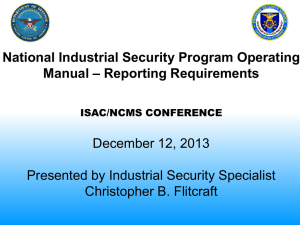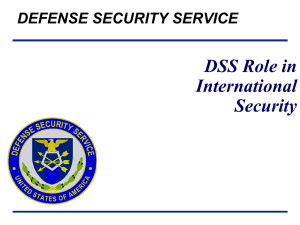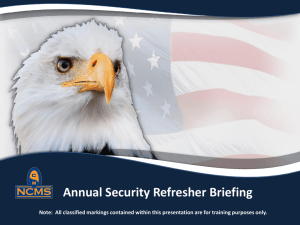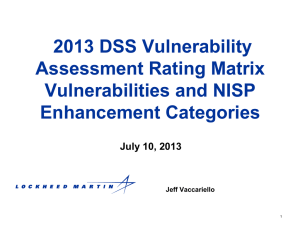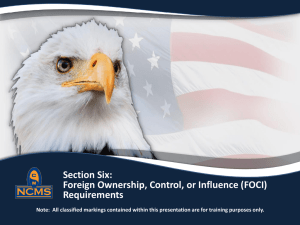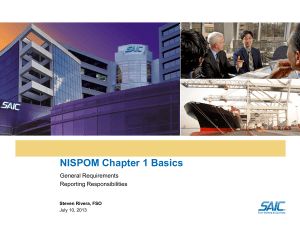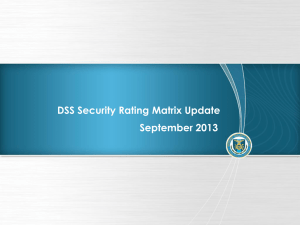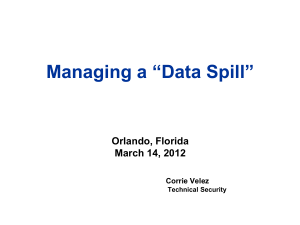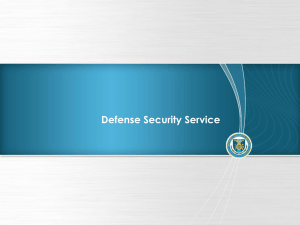Rating Matrix Briefing Sept 2013 - Florida Industrial Security
advertisement
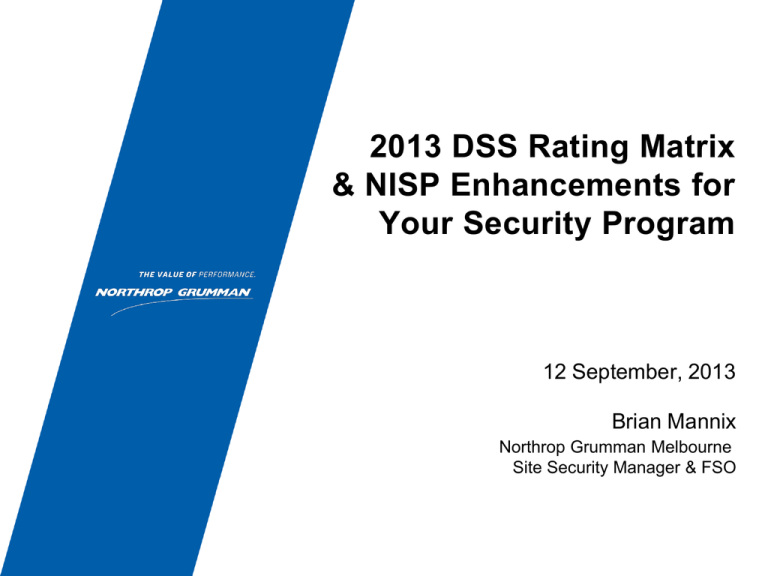
2013 DSS Rating Matrix & NISP Enhancements for Your Security Program 12 September, 2013 Brian Mannix Northrop Grumman Melbourne Site Security Manager & FSO Security Rating Matrix • Objective is to provide a standardized approach to issuing security ratings throughout DSS • Provides a quantitative approach to assessing facilities utilizing a standard worksheet • The worksheet is a DSS tool, designed to standardize and improve consistency • Numerically based, quantifiable, and accounts for all aspects of a facility’s involvement in the NISP 2 Security Rating Matrix • Points based rating system • All facilities start with the same score (700) • Points are added for identified National Industrial Security Program (NISP) Enhancements • Points are subtracted for vulnerabilities by NISPOM reference • Acute/Critical and Non-Acute/Non-Critical vulnerabilities are weighted separately • Points are subtracted by NISPOM reference, not by number of occurrences • Accounts for size and complexity of a facility 3 Security Rating Matrix – 2013 Update • Implemented September 1st • Not a drastic change from previous approach – builds upon the original implementation to further add clarity, drive consistency, and encourage more robust security programs • DSS collected feedback on original system from field personnel and industry partners – Objective is to refine a more transparent, consistent, objective process designed to identify and mitigate vulnerabilities while recognizing practices in place that enhance security programs beyond baseline NISPOM requirements 4 2013 Rating Matrix 5 Changes to Enhancement Categories • Removed Cyber Security from Counterintelligence Integration • Combined FOCI & International • Combined Membership/Attendance in Security Community Events & Active Participation in the Security Community • Removed Personnel Security 6 Vulnerabilities • Acute Vulnerability – Vulnerabilities that put classified information at imminent risk of loss or compromise, or that have already resulted in the compromise of classified information. Acute vulnerabilities require immediate corrective action. • Critical Vulnerability - Those instances of NISPOM non-compliance vulnerabilities that are serious, or that may place classified information at risk or in danger of loss or compromise • Once a vulnerability is determined to be acute or critical, it is further categorized as either “Isolated”, “Systemic”, or “Repeat” • All other Vulnerabilities are defined as non-compliance with a NISPOM requirement that does not place classified information in danger of loss or compromise 7 Common Vulnerabilities 8 • Failure to initiate a preliminary inquiry upon notification of a report of loss, compromise, or suspected compromise of classified information • Failure to appropriately mark classified information and material • Retaining classified information from an expired contract beyond the authorized two-year retention period without obtaining written retention authority from the government contracting activity • Failure to change safe combinations to closed areas/containers when employees having access were terminated • Operating an information system that is or will process classified information without appropriate approval • Failure to perform audits on classified systems • Lack of anti-virus software • Unreported FCL change conditions • Periodic reinvestigations out of scope Enhancements • A NISP enhancement directly relates to and enhances the protection of classified information beyond baseline NISPOM requirements – Directly related to the NISP and does not include other commonplace security measures or best practices • NISP enhancements will be validated during the assessment as having an effective impact on the overall security program • In order for an enhancement to be granted the facility must meet the baseline NISPOM requirements in that area – An enhancement directly related to a NISPOM requirement cited for a vulnerability may not be granted • If there are other effective enhancement activities in a specific category unrelated to a specific vulnerability in that category the enhancement credit may still be granted 9 Rating Matrix Categories • Category 1: Company Sponsored Events • Category 2: Internal Educational Brochures/Products • Category 3: Security Staff Professionalization • Category 4: Information & Product Sharing within Security Community • Category 5: Active Membership in Security Community • Category 6: Contractor Self-Review • Category 7: Counterintelligence Integration • Category 8: FOCI / International • Category 9: Classified Material Controls/Physical Security 10 • Category 10: Information Systems Presentation of Enhancements • Must be presented at the beginning of the assessment • Provide documentation supporting enhancements to the DSS rep • DSS must be able to validate the enhancement • Make the validation as easy as possible – Identify the enhancements that you believe you qualify for and state why you feel your program qualifies for it – Provide all supporting documentation – Keep it neat, organized, and concise • Consider using a binder, folder, or some other mechanism to provide all supporting information in one place 11 Category 1: Company Sponsored Events • The facility holds company sponsored events – Intent of this category is to encourage cleared contractors to actively set time aside highlighting security awareness and education. This should not be a distribution of a paper or email briefing, but rather some type of interactive in person activity. • Security awareness month/week, Lunch & Learn session, Guest Speaker, Hosting Security Webinar – Free speakers available within Government & Industry (use the contacts you make today) – Lunch sessions don’t require a charge number • Consider a raffle or give-away to boost attendance • Host a FISWG/NCMS meeting (guest speaker will be coordinated for you) – Invite your employee population • Conduct training at a customer location or have employees attend training at another contractor facility • Be sure to document attendance at all training/briefing session for your validation file 12 Category 2: Internal Educational Brochures/Products • A security education and awareness program that provides enhanced security education courses or products to the entire employee population • Monthly/weekly security updates or notices or write an article for a corporate publication – • Have department heads brief it in their staff meetings or better yet have them let you brief it Distribute security education information received from outside sources (Government, security organizations, professional societies etc.) – Be sure that the content is relevant to your Security program (comment on the newsletter/article; identify how it is applicable at your facility) – Many sources available • • Develop training products for uncleared employees that train them on companies FCL and how it may affect them – • Keep them updated, they are available free of charge from many sources • FISWG Website http://fiswg.research.ucf.edu/education.html • DSS CDSE http://www.cdse.edu/resources/posters.html • IOSS OPSEC Posters https://www.iad.gov/ioss/department/posters-10016.cfm?startPage=31 • Google “Security Posters” (be sure to not violate any copyright protection) Items not considered as an Enhancement – 13 Suspicious contact reports, adverse information reports, how to recognize unprotected classified information and how to properly report it Posters/brochures posted around facility – • FBI Tampa National Security Threat Awareness Monthly Bulletin Forwarding the DSS newsletter, annual refresher training for cleared population, PII training Category 3: Security Staff Professionalization • Security staff training exceeds NISPOM and DSS requirements and incorporates that knowledge into NISP administration – Intent of this category is to encourage security program’s key personnel to actively strive to learn more and further their professional security expertise beyond mandatory requirements • Obtaining and maintaining professional certifications – Certified Protection Professional (CPP), SPeD Certification, Computer Information Systems Security Professional (CISSP), Industrial Security Professional (ISP) etc. • Partial completion of a training program (beyond base training requirements per NISPOM 3-102 and 8-101b) – Final training certificate is not a requirement to receive credit • Additional CDSE courses, STEPP courses, NCMS “brown bag” training sessions • Items not considered as an Enhancement – Currently possess a certification but has not taken any training or ongoing certification maintenance within the assessment cycle – Taking a 20 minute CDSE course won’t meet the criteria, must show that a significant effort has been made to further education on topics relative to your operation 14 Category 4: Information/Product Sharing within Community • Facility Security Officer (FSO) provides peer training support within the security community and/or shares security products/services with other cleared contractors outside their corporate family – Intent of this category is to encourage cleared contractors to actively reach out to other cleared contractors to assist those who may not have the expertise or budget and provide them with security products, services, etc. • Sharing classified destruction equipment with the local security community or serve as a source for fingerprinting employees from other cleared contractors • Provide training and support for new facilities – Electronic Facility Clearance (eFCL), JPAS, Electronic Questionnaire for Investigations Processing (eQIP), Technology Control Plans, Transportation Plans, Self Inspection etc. • Serve as a mentor to another security professional – In most cases the mentor gets just as much out of the relationship as the mentee • Items not considered as an Enhancement – – 15 Sharing or providing products/services to companies or agencies that are not participating in the National Industrial Security Program Any of these activities related to or in conjunction with security organizations such as Industrial Security Awareness Council (ISAC), National Classification Management Society (NCMS), American Society for Industrial Security (ASIS), etc. Items relating to these types of groups would fall under Category 5. Category 5: Active Membership in Security Community • Security personnel are members and actively participate with NISP/security-related professional organizations – Intent of this category is to encourage security programs to actively collaborate with their local security community to identify best practices to implement within their own NISP security programs • Membership and active participation in NCMS, FISWG, NISPPAC, AIA, NDIA, ASIS, ISAC etc. – Just being a member won’t count as active participation – Hold a board member position, participate on a committee, or volunteer to assist at an event – Attend as many sessions as possible and keep attendance certificates/meeting documentation for your validation file • Verification of enhancement is aimed at determining what were the take-aways from events, how do they apply to the facility’s security program and how is the security staff implementing this information • Security personnel unable to attend meetings on a regular basis can collaborate virtually via the organization’s websites, email etc. (document for validation) • Hosting or speaking at professional organization meeting or seminar 16 Category 6: Contractor Self Review • Implement a thorough, impactful review of your security posture – Intent of this category is to encourage cleared contractors to maintain an effective, on-going self-review program to analyze and identify any threats or vulnerabilities within their program and coordinate with DSS to address those issues prior to the annual assessment • Provide DSS with a detailed report of your self-review to include identified threats or vulnerabilities, analysis, and countermeasures to mitigate vulnerabilities, and collaborate with DSS to correct prior to the annual assessment • Conduct multiple documented self-reviews providing an on-going, continuous evaluation of the security program • Participate in an internal corporate review program and have another site review your program • Participate in a review with another contractor that you have a contractual relationship with – i.e. prime contractor assisting a subcontractor or a consultant with an applicable need-to-know (DD254) • Items not considered as an Enhancement – – 17 Using only the CDSE Self-Inspection Handbook for Contractors or sending the checklists to DSS without a comprehensive analysis and vulnerability mitigation plan Conducting partial or incomplete self inspections and not closing out actions to mitigate vulnerabilities found Category 7: Counterintelligence Integration • Build a counterintelligence (CI) focused culture by implementing processes within their security program to detect, deter, and expeditiously report suspicious activities to DSS through submission of suspicious contact reports (SCR) – • Implement effective foreign travel pre-briefings and de-briefings designed to identify contacts or activities displaying potential espionage indicators – Conduct in person or by phone – Use relevant information to the where is individual is traveling • Implement an effective Insider Threat program designed to identify employees displaying potential espionage indicators • Notify DSS of all incoming and outgoing foreign visitors prior to occurrence and assist with IC activities, to include implement briefing and debriefing program for persons hosting foreign visitors – • 18 Intent of this category is to encourage cleared contractors to develop vigorous and effective CI programs that thwart foreign attempts to acquire classified and sensitive technologies. Critical elements of a vigorous and effective CI program include timely reporting, understanding the threat environment, and agile and authoritative decision making to neutralize or mitigate vulnerabilities and threats. cooperate with Intel and Law Enforcement communities when pursuing potential penetrators Items not considered as an Enhancement – Using sterile travel laptops with full disk encryption for employees travelling OCONUS – Utilizing a centralized mailbox to collect potential SCR notifications – Effective awareness program that ensures all employees (cleared and uncleared) are cognizant of individual reporting responsibilities Category 8: FOCI / International • • • Implement additional effective procedures to mitigate risk to export controlled items and/or FOCI – Intent of this category is to encourage cleared contractors to implement an enhanced export control program increasing the effectiveness. For FOCI mitigated facilities, intent is to encourage activities above mitigation instrument requirements to further minimize foreign influence at the facility. – Items which are requirements of the mitigation instrument may not be counted as enhancements International – Establish briefing and debriefing program for persons hosting foreign visitors – Develop a Foreign Visitor management system to include foreign national visitors being approved by export control and security before arrival – Conduct security briefs for all FN visitors on the TCP – Conduct, or have outside experts conduct, ongoing export compliance audits and share the results with interested U.S. Government Agencies FOCI – Performs significant trend analysis of internal governance processes and interactions with the foreign parent company and affiliates – Implement and maintain a system for automatic designation of emails to/from foreign parent/affiliates – Require that all electronic communications to the parent or affiliates obtain advance approval – Outside Directors, Proxy Holders, or Trustees interact directly with the cleared contractor site employees (training program, vulnerability assessment, compliance visits, etc.) with effective impacts – Appoint additional Outside Directors, Proxy Holders, or Trustees • 19 Must demonstrate the benefit in additional FOCI oversight these persons add (i.e. OD is assigned specifically to monitor and report on X) Category 9: Classified Material Controls / Physical Security • Deploy an enhanced process for managing classified information and/or implement additional Physical Security measures, with built-in features to identify anomalies. – • 100% inventory and accountability for Secret and Confidential material – Working papers are fully marked and accounted for regardless of date of creation • Safe custodian performs 100% check-in/check-out of materials & reviews material for appropriate markings and classification • Monitored and recorded CCTV, card access readers, biometric equipment strategically positioned around controlled areas with on-going analysis of data • Enhance supplemental controls with written procedures outlining guard personnel responsibilities to include: – • 20 Intent of this category is to encourage security programs to maximize the protection and accountability of classified material on-site by implementing effective processes, regardless of quantity of classified holdings verifying safes, closed areas, etc. are properly secured and verifying areas are free of classified information and maintain documentation of performance Items not considered as an Enhancement – Establishment of documented tracking system for inspections of areas above and below false ceilings/floors in Closed Areas – Combination changes more frequently than required – 100% inventory conducted during self-inspection does not count towards enhancement – Enhanced supplemental controls that do not have an impact on protection of classified information are not counted as enhancement Category 10: Information Systems • Incorporating process enhancements and leveraging tools to expand the overall security posture of accredited information systems – • Development and use of a formalized SOP and a comprehensive checklist to augment a detailed weekly audit review process which describes what is performed during the review of large, complex IS (LANs/WANs) with multiple Operating Systems • Additional IS oversight processes put in place to enhance security of classified information residing on IS • Develop, implement, and utilize significant and effective (LAN/WAN based) Information System audit trail reduction/collection or analysis tools/scripts – 21 Intent of this category is to encourage security programs to maximize protection of classified information on IS These tools help focus on real security relevant events while minimizing the amount of non-security relevant data extracted within the audits • Use of a file or scripts that tracks downloaded files, unauthorized classified downloads, or unauthorized USB connections and review/auditing of report outputs • Utilize scripts to maintain compliance to the SSP and ODAA's baseline – The scripts validate Security Relevant Object (SRO) settings and report back if discrepancies are found – ISSM reviews and acts on report findings Category 10: Information Systems • Items not considered as an Enhancement – ISSM or ISSO is certified (this would fall under Category 3) – Employing a color coded labeling system for components for both classified and unclassified networks – Providing additional user training, briefings, etc. to people who are going to hold the privileged user position – Developing reports that identify when a system is due for re-accreditation, systems that are in the ODAA process for a period of time, when audits should be performed on accredited systems – Developing a method to patch and maintain time on air gapped systems – Utilizing scripts to apply and maintain antivirus definition updates – Utilize a method to track SID numbers 22
